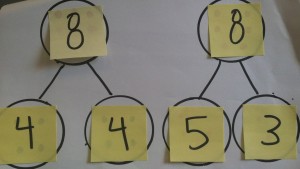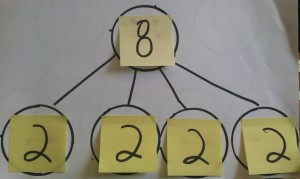These past few weeks have been a bit busy for me. So much great stuff has been going on, but I haven’t had a chance to write about any of it. This week, I forced myself to sit down and write a little bit so I don’t forget all of it.
One of the things I’ve been thinking about is how to develop number sense with young students. Building strong number sense is one of the most important things elementary school teachers can do. There are many ways to do it and I’ve been trying to figure out the advantages and disadvantages of different strategies.
The activities that are particularly interesting to me help develop students’ ability to decompose and recompose numbers. Understanding that a whole can be composed from different parts is a big idea for students. They don’t see a connection between all the different facts that for example, add to 8.
Students who develop these connections will have an easier time developing the big idea of decomposing numbers. When faced with a fact like 9 + 6, they can think about decomposing either of the numbers into parts that may make the calculation easier. For example, by decomposing the 6 into 1+ 5, they can think about adding the 1 to the 9 to make 10 and then adding the 5 to the 10 to get 15.
So how do we help students decompose and recompose numbers?
Number bonds are one way. I like them because they can help students visualize the different parts that can be used to create a certain number.
You can start by having students use hands-on materials, like cubes and counters, and asking them to find all the different ways they can break a number into parts. They can then represent what they are doing with a picture. Here are some different number bond diagrams for the number 8.
After students have had lots of practice with hands-on materials and drawing diagrams, they can then move to using numbers.
I like number bonds because they provide a nice visual for students to use to think about decomposing and recomposing numbers. Of course, this is just the beginning. Students then need to think about strategies for decomposing and recomposing numbers in ways that help make computations easier. However, I think it’s important to make sure students have this foundation.
What do you think? Do you use number bonds with your students? Are they helpful?
Want to know more? Check out: Baroody, A. J. (2006). Mastering the Basic Number Combinations. Teaching Children Mathematics, 23.




This is an excellent blog!